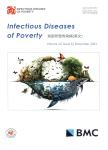Characterization of tungiasis infection and morbidity using thermography in Kenya revealed higher disease burden during COVID-19 school closures
作者机构:KEMRI-Wellcome Trust Research Programme Kilifi Kenya Centre for Tropical Medicine and Global Health Nuffield Department of Medicine University of Oxford Oxford UK International Centre of Insect Physiology and Ecology Human Health Theme Nairobi Kenya College of Veterinary Medicine Animal Resources and Biosecurity Makerere University Kampala Uganda Institute of Microbiology Infectious Diseases and Immunology Charité University Medicine Berlin Germany Institute for Parasitology and Tropical Veterinary Medicine Freie Universität Berlin Berlin Germany
出 版 物:《Infectious Diseases of Poverty》 (贫困所致传染病(英文))
年 卷 期:2023年第12卷第2期
页 面:120-121页
核心收录:
学科分类:1004[医学-公共卫生与预防医学(可授医学、理学学位)] 1002[医学-临床医学] 1001[医学-基础医学(可授医学、理学学位)] 100401[医学-流行病与卫生统计学] 10[医学]
基 金:Andrew Espira Styrelsen för Internationellt Utvecklingssamarbete, Sida Direktion für Entwicklung und Zusammenarbeit, DEZA Wellcome Trust, WT, (213724/Z/18/Z) Government of the Republic of Kenya, GoK Deutsche Forschungsgemeinschaft, DFG, (405027164, KR 2245/7-1)
主 题:Tungiasis Neglected tropical diseases Thermography Morbidity Child COVID-19 Kenya
摘 要:Background Tungiasis is a neglected tropical skin disease caused by the sand flea Tunga *** fleas penetrate the skin,particularly at the feet,and cause severe *** study aimed to characterize disease burden in two highly affected regions in Kenya,to test the use of thermography to detect tungiasis-associated inflammation and to create a new two-level classification of disease severity suitable for mapping,targeting,and monitoring *** From February 2020 to April 2021,3532 pupils age 8–14 years were quasi-randomly selected in 35 public primary schools and examined for tungiasis and associated *** the infected pupils,266 were quasi-randomly selected and their households visited,where an additional 1138 family members were *** was assessed using infra-red thermography.A Clinical score was created combining the number of locations on the feet with acute and chronic symptoms and infra-red *** The overall prevalence of tungiasis among all the school pupils who were randomly selected during survey rounds 1 and 3 was 9.3%[95%confidence interval(CI):8.4–10.3].Based on mixed effects logistic models,the odds of infection with tungiasis among school pupils was three times higher in Kwale(coastal Kenya)than in Siaya[western Kenya;adjusted odds ratio(aOR)=0.36,95%CI:0.18–0.74];three times higher in males than in females(aOR=3.0,95%CI:2.32–3.91)and three times lower among pupils sleeping in a house with a concrete floor(aOR=0.32,95%CI:0.24–0.44).The odds of finding an infected person among the household population during surveys before the COVID-19 pandemic was a third(aOR=0.32,95%CI:0.19–0.53)of that when schools were closed due to COVID-19 restrictions and approximately half(aOR=0.44,95%CI:0.29–0.68)in surveys done after school re-opening(round 3).Infection intensity was positively correlated with inflammation as measured by thermography(Spearman’s rho=0.68,P0.001)and with the clinical score(rho=0



